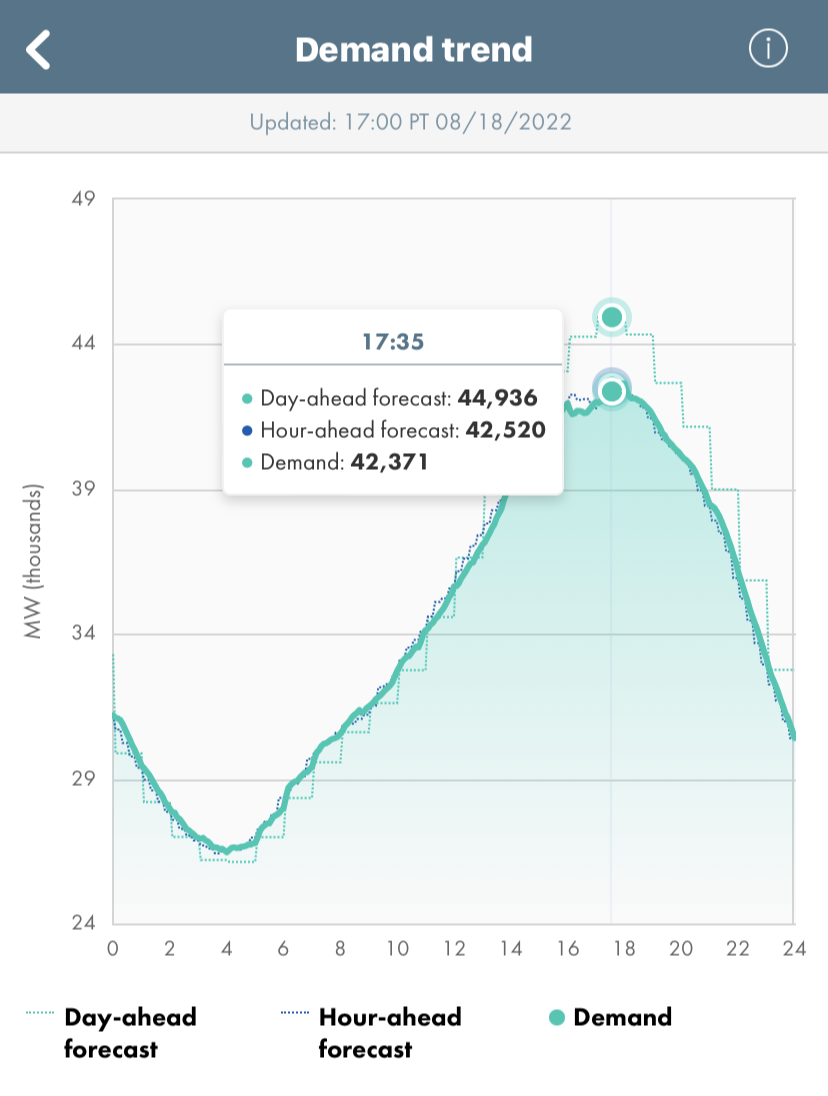With our free press under threat and federal funding for public media gone, your support matters more than ever. Help keep the LAist newsroom strong, become a monthly member or increase your support today.
Another Flex Alert Has Been Issued. Here’s Why You Should Cut Back Your Power Use

Issuing a flex alert Wednesday, California Independent System Operator called for voluntary electricity cutbacks from 4 p.m. to 9 p.m., and then later extended the alert into Thursday. It wasn't the first flex alert of the summer, and it almost certainly won't be the last, as excessive heat is forecast through Labor Day weekend.
Cal-ISO Recommends You Take The Following Steps
Before 4 p.m.:
- Pre-cool home by setting the thermostat to as low as 72 degrees
- Use major appliances, including:
- Washer and dryer
- Dishwasher
- Oven and stove for pre-cooking and preparing meals
- Charge electric vehicles
- Adjust blinds and drapes to cover windows
From 4 p.m. to 9 p.m.:
- Set thermostat to 78 degrees or higher, if health permits
- Avoid using major appliances and charging electric vehicles
- Turn off all unnecessary lights
Imagine this scenario: It’s hot. You’re sweating. Every fan in your home is on, plus your A/C. Then you hear that a dreaded flex alert was issued. All of a sudden, you’re being asked to turn up your A/C to at least 78 degrees to help conserve energy.
But why must we all sweat for the greater good?
Flex alerts happen when managers think power demands could outstrip supply. They're a big, statewide ask. When they’re issued, the state’s power grid manager, California Independent System Operator (Cal-ISO), requests that every person voluntarily cut electricity use.
Extreme heat is deadly — and power is often the only way people stay cool when temperatures are high. So reducing energy use is a major way residents can help prevent full-on blackouts and shortages.
So instead of dismissing that flex alert (I know that’s easy to do), here’s why you should pay attention.
Why Do We Need Flex Alerts?
Flex alerts aren’t that common, so when they’re called it’s for good reason.
Cal-ISO typically calls an alert when temperatures are hot. Energy consumption runs higher during these times, so people need to cut down. But heat isn’t the only factor. All of these issues can put a strain on our state’s power grid.
- We import power to our grid from other states, so any bad weather there can also affect us. And while the sun is our ever-present resource for solar energy, its energy is not always available. Dense monsoonal clouds can block out the sun for solar production.
- Part of the reason for the flex alert time frame (4 to 9 p.m.) is also sunshine-related. Solar production stops as the sun goes down, which could mean a supply and demand imbalance during a heatwave.
- Hot summer nights can even keep buildings warmer than usual.
While Cal-ISO didn’t have a set goal for Wednesday’s flex alert, according to public information officer Anne Gonzales, the agency does monitor outcomes. "We know that there is a reduction, but we are still analyzing the specific data from a Flex Alert,” she said in an email.
Have Flex Alerts Worked Before?
Yes, but the alerts rely on everyone doing their part.
Sometimes, if power use isn’t reduced enough, the alerts can be extended to more days. The last time that happened was during a heatwave in September 2021.
Longer flex alerts can be a good indicator of how well residents are responding to the request to cut power use.
If you’re curious, the agency has a phone app where anyone can check out the state’s electricity demands and expectations by the hour. It’s called ISO Today.
Here’s how power use during Wednesday’s flex alert held up:

You can also see how much energy we have in reserve. Flex alerts add a cushion to that. Think about the alerts like an added barrier. It’s a stopgap that keeps public awareness about power use high, before it gets really bad.
So by sweating a little bit more and not using your washing machine in the evening, the energy you save during a flex alert can help keep the lights on for everyone.
How You Can Save Energy
Set your air conditioning at 78 or higher. If you can turn it off and use a fan instead, even better. You can pre-cool your house to 72 in the morning hours when there is lower demand on the power system, then when you set it to 78 in the afternoon, it won’t be quite as unbearable.
Unplug “energy vampires” -- those appliances that are sucking power from the grid even when they are not being used, like a microwave oven, and phone chargers.
Close drapes and blinds to keep your home cooler inside. Turn off unneeded lights.
Wait until the early morning or late evening hours to run the washing machine or dishwasher, or vacuum.
If you have an electric car, don't charge it in those afternoon or evening hours
For those lucky enough to have a pool, do your part by turning off your pool pump.
Updated August 31, 2022 at 1:20 PM PDT
This story was updated with a new flex alert for Aug. 31.








